Dragonsbane's High Hopes Go Unfulfilled at 35th Heineken Regatta "Serious Fun" Fulfilled - By Matthew O'Keefe
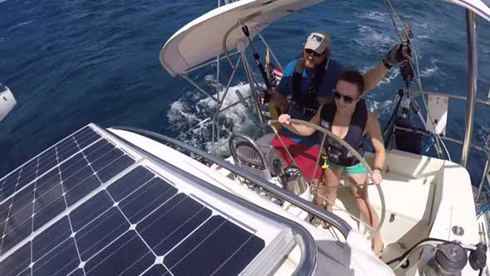
Allison O’Keefe being coached by Jacques Soumis in helming Dragonsbane on first practice day.
My daughter Allison and I set aside the first week in March 2015 to sail in the Heineken Regatta in St. Maarten with a crew put together by Captain Thom Burns of Northern Breezes Sailing School (and Sailing Breezes Online Magazine). Being relatively new to sailing, both Allison and I looked forward to the chance to build more experience in sailing and crewing a racing boat. And we also wanted to find out why “Serious Fun” is the Heineken Regatta motto.
Captain Thom originally chartered a Jeanneau 494 for the race, but it subsequently became unavailable. So he instead struck an agreement with Captain Dale Soumis of DePere, Wisconsin to jointly crew Dragonsbane, Soumis’ 43-foot Sceptre yacht. Conveniently, this boat had recently arrived in St. Maarten after a 6012 nautical mile trans-Atlantic crossing originating in Cape Town, South Africa. In fact, Dragonsbane’s captain, Dale’s son Jacques, had just completed a circumnavigation of the world aboard Dragonsbane, for that story see Jacque’s blog at dragonsbanevoyage.com.
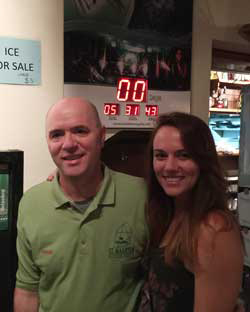
Matthew O’Keefe with daughter, Allison at the St. Maarten Yacht Club
with 5 hours 31 minutes 43 seconds before the start of the first race; Timer to “Serious Fun.”
After clearing out unnecessary equipment - including all but 1 of 4 anchors, 400 feet of chain, and numerous other items estimated to weigh more than a ton - and making minor repairs, she was ready for 4 days of training before the race.
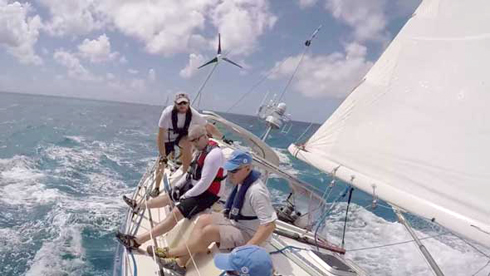
Captain Dale Fitch, foreground, Jon Burns, middle, and Jacques Soumis crouched, positioning to the high side going upwind. Notice all the “cruising” gear: wind generator, solar panels, radar mount with satellite antennas and GPS on the aft of the boat. This is the type of boat which should be in the “Lottery Class.”
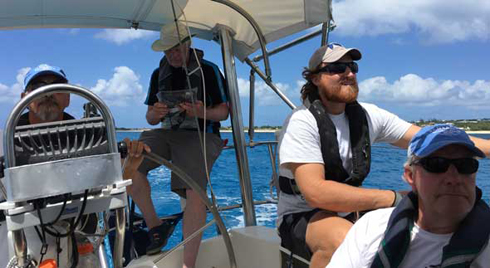
Captain Dale Soumis driving, Captain Thom Burns in the background studying iPad, Jacques Soumis and Roger Olsen in the foreground.
Our crew consisted of Captain Dale Soumis, his son Jacques and two friends Roger Olsen and Don Link. Captains Dale Fitch and Thom Burns brought additional crew members including Allison and I in reserve, along with Tim Giesen, Jon Burns and Martin Evans. The crew came from varied geographies (including England, Manhattan, Minneapolis, Michigan, Wisconsin and North Dakota) and racing backgrounds — from no experience, to accomplished cruising class winners, one-design racers, and various national competitions with Heineken wins already on their resumes.
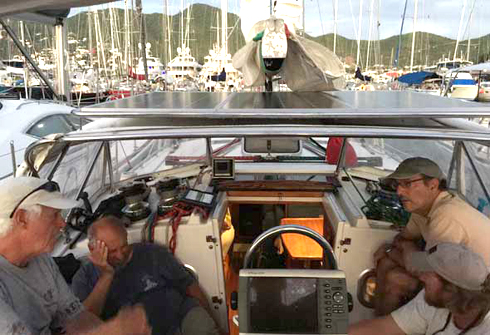
Captain Thom Burns, foreground left, conducts crew debrief after practice and races to help with familiarization to boat and avoiding mistakes. Owner, Captain Dale Soumis with hand on head, Tim Giesen, and Jacques Soumis, foreground right. Note the second set of solar panels. Dragonsbane had not been connected to shore power in over a year!
Captains Fitch and Burns had teamed up in past Heineken races to lead winning boats in the lottery class, and there were high hopes for more first place wins this year in a slightly different race format. Dragonsbane’s weight and deep keel would allow her to sail well in the high winds (25 - 30 plus) and heavy seas which were expected and seen during the practice days and the first two races. Three head sails, a staysail and an ounce and a half spinnaker as well as an asymmetrical spinnaker and symmetrical spinnaker completed the sail inventory. This inventory would give a wide range of sail options. Powering up Dragonsbane should not have been a problem according to Captains Burns and Fitch through the bigger waves caused by the high winds and northerly swell from storms in the U.S. in the waters around St. Maarten.
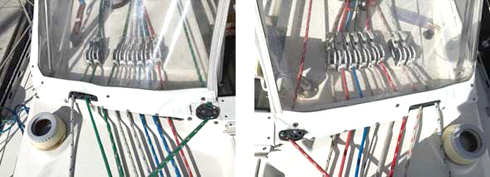
With 18 lines leading to the cockpit, there is plenty of complexity to this “Cruising” boat.
The pit crew of Tim Giesen, Jon Burns and Martin Evans with Jacques Soumis as trainor in backup
mode had plenty of challenges.
Which leads to another question: what makes the Heineken Regatta the biggest race in the Caribbean each year? And, why is it held in St. Maarten? First, the waters around St. Maarten are mostly free of other large islands and reefs, and there is sufficient depth for even large boats to sail right up to most shorelines. Thus race officials who are setting courses have a lot of freedom to develop routes with varying turns and distances - courses generally range from 10 to nearly 40 nautical miles. Windier days call for longer courses to keep the boats out for a 3- to 4-hour race. Second, long-running sponsorship by Heineken combined with deep support from local volunteers, especially the St. Maarten Yacht Club, has yielded a race with the history, scale, and quality to continue to attract hundreds of boats every year. The big parties at the end of each day of racing certainly appeal to the exhausted, thirsty sailors.
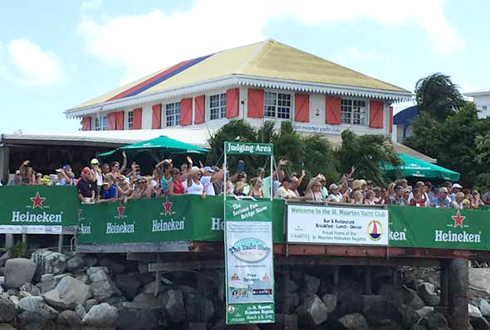
Passing the St. Maarten Yacht Club while entering or leaving Simpson Bay Lagoon is always a festive occasion! The bridge operator on the VHF radio should be recorded as he coaches, cajoles and otherwise “assists” boats to move through the bridge area quickly to avoid massive vehicle traffic jams.
During training, flying a high wind ounce and a half spinnaker was initially a primary focus, after tacks and jibes. This would give Dragonsbane an advantage if we could fly this chute safely and under control in higher winds. The hope was that it would give us an edge compared to the lighter, competitors boats, but the winds during practice mid-20s with gusts to 30 plus nautical miles an hour — were simply too high to successfully practice and bring the crew along. Only the most seasoned crews could fly chutes. Even a couple of the most experienced crews in heavy duty race classes made mistakes and blew sails. Getting spinnakers up and down in high winds is notoriously tricky and error-prone. Mishaps can do more than cost you the race. They can be dangerous to the crew and the boat.
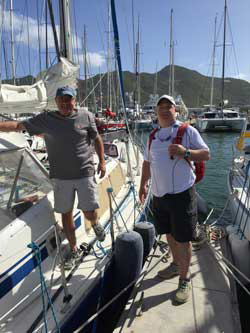
Don Link on the left and Martin Evans from the St. Louis area just after docking at Simpson Bay Marina.
Thom and Dale decided to use only sail combinations which had been successfully practiced. The main, genoas, staysail and asymmetrical for light winds met these requirements after disappointing attempts to run the ounce and a half spinnaker on two successive practice days in very strong gusty winds.
During training, positions were distributed to crew members including jib sheet trimmers, the pit which included main sheet trimming, halyards, reefing, traveler, and all eighteen rope clutches on the coach roof; the mast, the helm and the foredeck with Captains Burns and Fitch working together as tacticians. Our crew used the training days to improve speed and efficiency on sail trimming and operations, especially tacking and jibing.
Learning how to communicate and operate as a team was a key focus.
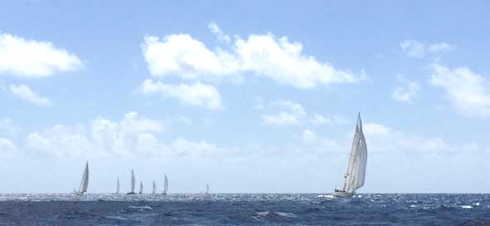
Leading the pack for a while downwind in race two!
Watching experienced tacticians like Burns and Fitch work during the race was revealing. A good race tactician is really a coach. He trains the crew, plots the best strategy for the race based on the combination of race conditions, courses, boat characteristics, and crew strengths - and weaknesses. During the race he also calls sail changes, how sails should be trimmed, what course to follow, how to respond to competitor’s maneuvers all the while gathering in as much information about on-the-water conditions that can be exploited to get ahead in the race or stay there. Finally, he shouts encouragement, berates slow responses and poor performance while giving you the chance to do better the next time. Good tacticians win races that are winnable.
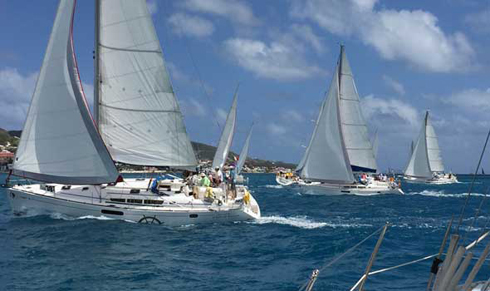
An earlier starting class crossing Dragonsbane on starboard on day two.
So how did Dragonsbane perform at the Heineken?
In the Heineken lottery class, each day is a separate race. On the three race days, with 16 boats in class, Dragonsbane finished 4th, 7th, and 9th; overall for the three days of racing, she finished in the middle of the pack at 7th. Interestingly, the overall winner, Domini, did not finish 1st on any day, but finished 3rd, 2nd, and 2nd. In contrast, Amethyste, Feeks, and Tequila Tango finished first on separate race days but 4th, 5th, and 9th overall, so consistency on each race day was the key to overall victory this year.
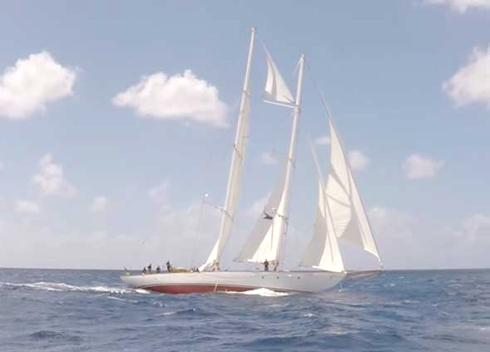
A beautiful competitor, “Atrevida” a 104-foot Nathaniel Herreshoff design, the
Heineken attracts all types of yachts.
Asked about the race results, Captain Thom responded: "Consistency is almost always the key to winning. Each day the best crews get better. We suffered through a couple of spinnaker issues which were related to high winds, waves and inexperience. This caused us to rethink what sail combos were reasonably possible. It was so windy on the first day that it didn't affect us much. On the second day we were in first or second until the asymmetrical, which was not secured properly, slipped off the deck into the water. Three or four boats passed us and another couple corrected over us because of the delay in retrieving the sail. Fortunately, the only damage was to a stanchion. The sail was okay and it did not foul the rudder, prop or keel. On the third day, the winds were light which highly favored light boats.
Dragonsbane is certainly not light. I was very concerned with possible sail damage because we did not have a proper feeder to peel jibs from the 120 percent genoa to the 135 or 150 which was the right sail call. With the boat stuck in the middle of the pack, I called for the asymmetrical. We were able to launch it and jibe it which probably did not gain us much distance. But the crew satisfaction that they could accomplish this tricky maneuver made it worthwhile. Erasing bad race practice memories, even on the last legs of a regatta you know cannot be won is important. Had we had any practice day with these lighter winds, we probably could have perfected the high wind spinnaker. Overall the Heineken was a great time with great folks I hope to sail with again."
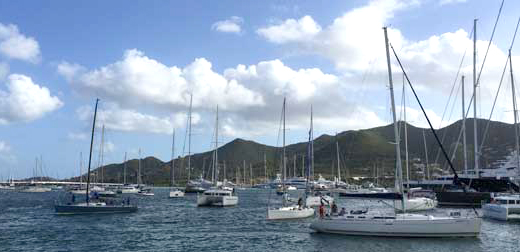
Most of these boats are moving to the choke point of the Simpson Bay Bridge, the causeway
bridge is in the background. It takes a high degree of close quartered station keeping to maneuver
single screw vessels amongst the crowd.
Captain Dale Fitch, "As I reflect back on the Heineken Regatta, it was a lot of
fun and exciting sailing with winds primarily in excess of 20 knots and often
nearing 30 knots. Dragonsbane is a very strong yacht and handled the windward
courses very well. I think that sailing is probably the ultimate team sport and
it is very difficult to assemble a crack team with only a couple of practice
sessions. I think that we had good speed upwind, and great starts, but we did
have a couple of miscues that cost us dearly and continue to haunt my memories
of the event. I think our crewmembers learned a lot and undoubtedly will be
better prepared for the next time around the marks."
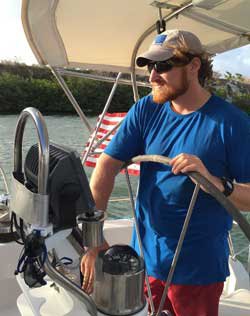
Jacques Soumis at the helm coming into Simpson Bay Marina. Backing into a slip with
one foot on either side, trade winds often blowing across the boat present special challenges,
Jacques was patient and kept docking fairly boring!
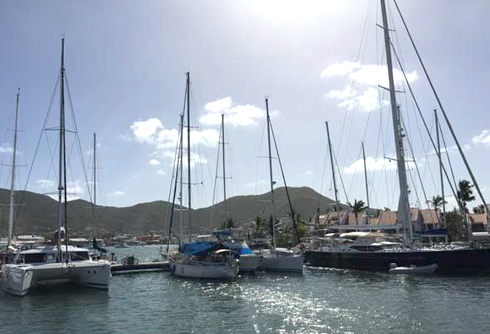
Simpson Bay Marina is a great location to base a Heineken Cup campaign! The marina has complete services and is surrounded with outstanding restaurants and watering holes.
It takes a lot of passion for sailing to drive a boat like Dragonsbane around the globe, so we weren’t surprised by Jacques’ feelings about the Heineken races: “To me it was a grand time to work with men of varying capabilities and to add to everyone's experience, including my own. Looking at Dragonsbane’s performance she did as expected. She worked hard and fast in rough seas and strong winds staying in front with our best finish being the first day. As the wind and sea cranked down, she fell behind. That said, I am hoping that our crew takes away the concept of an offshore, blue water racer like Dragonsbane. With her, she will rock you, dip you, punch rough swells, smile, and just keep on trucking in heavy seas. As for the next time this group of men passes paths, a real sense of freedom will be acknowledged and as for the future? Well, we only grow from our losses which only leads to champions. Myself, I am only going to dig deeper, try harder, plan more, and, pinching like Dragonsbane does, in 30 knots dig, dig, dig, and blast away to new freedoms.”
And Jacques had this good advice for the crew: “So rage into that good night men, hug your partner, kiss your kids, and don't look back. Unless you want to see who we are passing come 2016. Let your hurt feel good and let the pain go away!”
We couldn’t agree more with Captain Thom and Jacques about sailing with a great team. For both Allison and I, the good times and camaraderie combined with racing with some of the fastest sailboats on the planet brought home what “Serious Fun” at the Heineken races is all about.
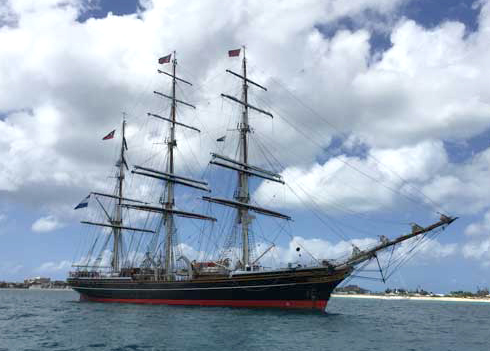
Above, one of the beautiful sights in Simpson Bay after a finish!
TOP
|